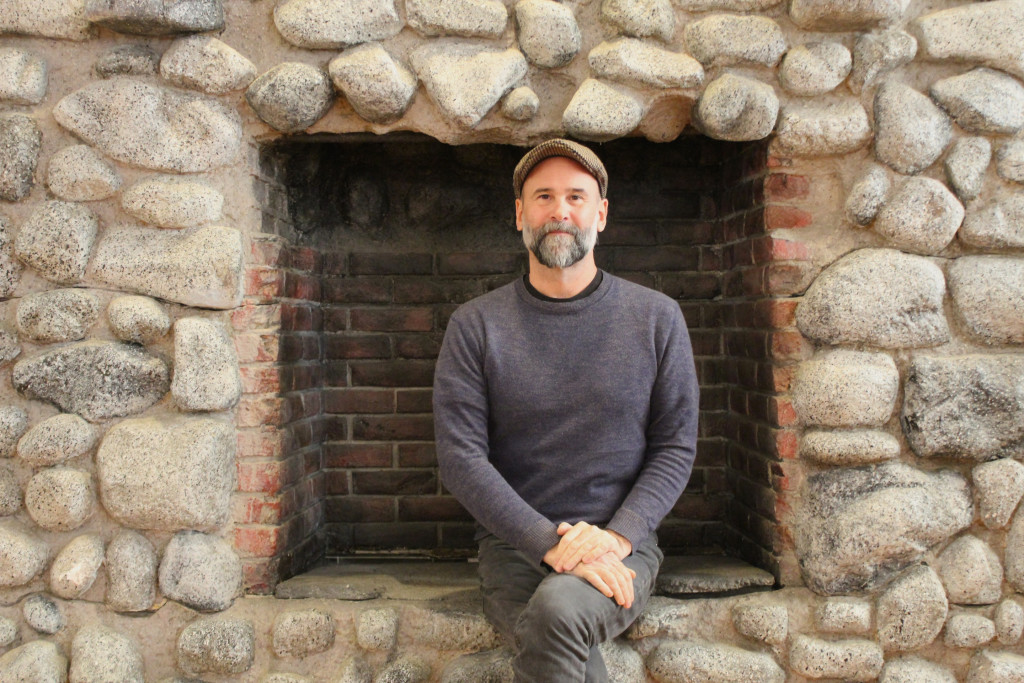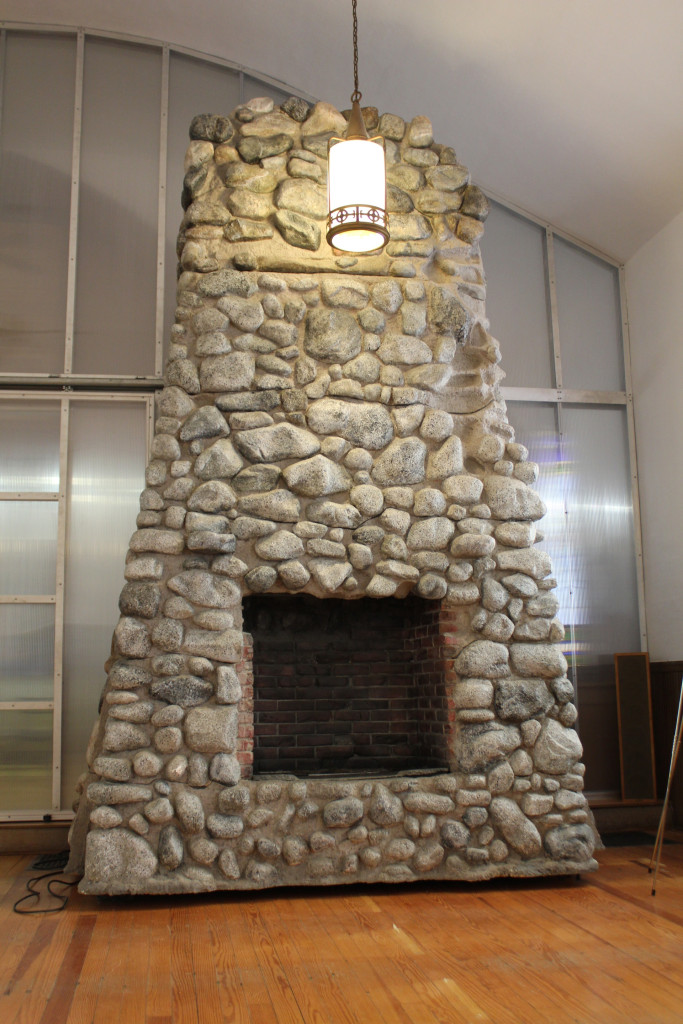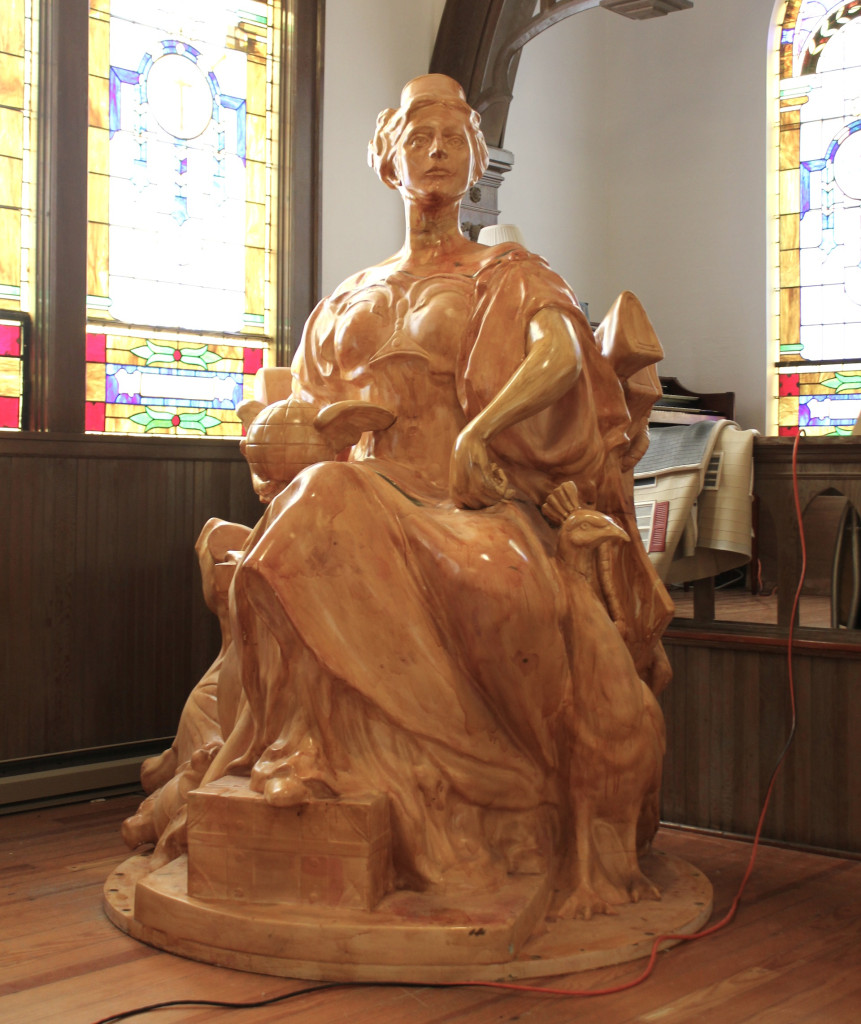What brought you to the Catskills?
We (Brian and his partner, Brian Clyne) had an apartment in the city and I had the studio for 20-odd years in Williamsburg in Brooklyn. We both grew up on Long Island, so we grew up close to the water but for whatever reason, we both had an affinity for the mountains. One summer – I think it was about the year 2000 – we had enough friends up here that we could spend two or three weeks up here as vagabonds, throughout the Catskills. We went to different regions, but this region in Delaware County was very appealing to us. There was something about the topography, the landscape and the history of all this that suited us very well.
What do you do up here?
I’m a sculptor, an artist. I moved back down to New York City after graduate school in 1994 and opened a studio in Williamsburg. At that time, Williamsburg was not a destination. It was industrial, very depressed and by extension a very inexpensive place to work. And so, as a young artist with very little money or resources, I rented a 2000 square foot space with a classmate of mine for about $250 each on a ground floor. As time went on Williamsburg became more expensive and developed. The rent that had been $500 had risen up to about $2,200 a month. They gave me a notice that they weren’t going to renew the lease and they were raising the rent to $25,000 a month. Williamsburg was becoming less and less attractive. I didn’t go to there to socialize. I went there to work and as lovely as the cafe and bar scene is there with the convenience of all the restaurants, it just became too much of an interference of what we were there to do, and that was work. They didn’t offer me the studio for $25,000; they didn’t want an art studio there. They wanted a storefront. So we were left with three months to move out, no option and no place to go. So I thought, OK, we can move out further east towards Bushwick, but the same thing’s happening out that way. I’ll settle down for five years and then get booted out. Again, I wasn’t in a position to buy a multi-million dollar building, which is what you need to buy anything in New York these days. We own 12 acres outside Fleischmanns and I thought, maybe I’ll start a studio out that way, but the price was still coming in way too high for what I wanted. So then we thought about buying an existing building and renovating it. I didn’t know that this building was available. In fact, I came to Roxbury to look at a gas station that was sold up the way, but it was too small for us. My Dad was looking for spaces for us and on the way back from the gas station he saw that there was a for sale sign by Our Lady of Good Counsel Catholic Church, which is now Roxbury Abbey, my studio. It certainly was big enough. It’s a 3,500 square foot building with 20-feet ceilings and big open spaces. I was able to acquire this building for what it would have cost me to pay three months rent back in Brooklyn. It was pretty much a no-brainer after we found it and then we set to the tasks of restoring all the plaster and clearing out all the extraneous catholic things.
We didn’t sell anything. There are people in the community that went to this church not too long ago so we didn’t want to be disrespectful in any way. All of the pews were donated to local people. We gave anything religious back to the catholic community, for example, the parish in Margaretville, where many of the Roxbury people moved to, lost their baptismal font in one of the floods, so we had a perfectly good baptismal font here that we had no use for, so we donated it to that parish.
It’s strange that the Catholic Church would leave everything behind like that [after selling the church].
I don’t know the details of it, but the building was owned once, prior to us, outside the church.
Did they take the altar with them?
No, the altar was here. The organ is here. It’s a really nice Hammond organ, but we have no interest in parting with that. It’s a real dance because we love the historical integrity of the building. It was built in 1925 in the craftsman style. So it’s a modest, but incredibly well built structure. We restored the interior and reconfigured things to make sense for us as a working space; insulated the building; there was no running water so we connected it to the town water. Now the next phase is to restore the exterior of the building
Did you build those two large, stone fireplaces (pictured below)? I can’t imagine how you would get those out of here.
They break down into seven parts.
Are they working?
Well, they do work, but not in the way that you think.
Intriguing.
It’s a sculpture called Alice and Job and they are hand carved in Styrofoam. I carved each and every rock one at a time and then hand painted them. They’re part of a show I did out in Los Angeles back in 2000. They are the only architectural remnants left of the socialist colony out in the Mojave Desert, the largest in American history. And so, I saw them as being monuments to the people who inhabited that place. It didn’t last for very long. I thought of these two chimneys as wandering the earth looking for likeminded socialists. Job and Alice are actually robots. They wander around. They have their own mind. It’s a random setting and when they get close to something they stop and rethink their positions, but they are constantly in a state of flux, searching for something.
What’s next for the studio? Will you move in here?
No, it’s an art studio. I’ve never lived where I’ve worked. I really do treat the work as if it’s any other type of job. At the end of the day, I like to go home and be away from it for a while. But right now, there’s so many things going on that if you were to go to my house, there are piles of things around there too. I mean, Brian is my life partner and he runs the studio, so there’s no way to separate completely from work.
I know and you always leave a piece of yourself behind in the studio when you leave. Don’t you find that?
Yes and I think that’s necessary. For me, it is. Other artists want to be completely immersed in it all the time. We have an exhibition opening at CRG Gallery in New York called POTUS that’s about the American presidency and it’s opening April 30th. I have a large commission for a finance company where we’re making 14 artworks for their corporate offices to be installed at the end of May. I’ve got a large-scale project at the intersection of Flatbush Avenue and Tillary Street in Brooklyn at the entrance to the Manhattan Bridge. Those two figures are part of the installation. (Miss Manhattan is pictured below).
What are they made of?
Well, those figures are Styrofoam, but they were milled using a computer-operated router. They are replicas of two sculptures that were made in around 1900 by Daniel Chester French who made the sculpture for the Lincoln Memorial. He was quite a famous sculptor and he was asked to design Miss Manhattan, as she was titled, and Miss Brooklyn. They once sat on plinths on either side of the Manhattan Bridge on the Brooklyn side. In 1960, Robert Moses, as part of his plan for a cross-Manhattan expressway, demolished the plaza in Brooklyn. But fortunately for us, the people of Manhattan were sufficiently organized that they stopped it from going through. If it had gone though, he would have destroyed most of Soho. Anyway, these figures were removed from their location and kept in the Brooklyn Museum for many years in a storage lot. I stumbled on the history of this plaza when I was asked by the City of New York to consider a sculpture for that intersection. As part of my usual work there’s a lot of research on the front end, not with any goal in mind necessarily, but just to put myself in a position to recognize something if it comes along. If you’ve seen this plaza, it’s gotten better over the years, but if you had seen it before the redevelopment it was very chaotic and odd and pedestrian-unfriendly. So I thought it would be interesting to put the two figures back. But we’re putting them back very differently, so they’re going to be on a single column on the median that’s 26 feet high, which is the height that they were originally perched at, and they sit very close together hovering above the roadway. They both rotate, so they will gaze into each other’s eyes and survey the surrounding area. In the final form, they will cast in this really beautiful translucent light acrylic so they look like alabaster and they have LEDs on the inside so at night, they will be illuminated.
That’s an ambitious project. Do you ever think about the logistics of it, or do you just go for it?
You know, when I first started, I was a one-man band. I made things on my own. I had no real money. I had no money for assistants. If I made ambitious projects, I usually had to rely on the help of friends, or Brian to pull something off. However, very early in my career, I was included in a competition for the Irish Hunger Memorial down in Battery Park City, which is a half-acre monument in Battery Park. That was back in 1999. I was 35 years old and I was asked to design probably the biggest permanent sculptural project in New York. I had to deal with politicians, unions, all sorts of trades, architects, media and so on.
And it catapulted you to fame?
It got a lot of attention. [Laughs] but you know its always a bit of a risk, you know, it could have been the biggest flop. If you’re going to build a seven million dollar project that people celebrate and enjoy, that’s one thing, but if you build something that everybody loathes…
Everything’s a risk.
Yes, everything’s a risk, but I didn’t really have time. I was the last person considered for that competition. I shouldn’t have even been on the roster basically.
Why not?
The art administrator, who put together 200-odd names, hadn’t thought of me for whatever reason. As co-incidence would have it, I sat on jury duty with her son and after jury duty, we exchanged phone numbers. He went back to his mother and told her he had met me. She called me within a couple of days telling me that she loved my work and asking if I would consider submitting my qualifications for it. She said, the one problem is that everything has to be in by Thursday. This was 1999. I didn’t even have the money to duplicate slides. It was like $25 per slide back then. I scrambled to get it done and the next thing I knew, I was a finalist. I’m a big believer in serendipity.
Me too.
I’m not superstitious, but I do think that sometimes things happen for reasons that can’t fully be explained.
It’s worth thinking about for a few seconds now because sometimes, when I think back on what’s happened in my life, I think how the hell did that happen?
Right. And you can either just sort of dismiss it or you can just let it do its thing and acknowledge that something hopefully positive happened.
I love your work. It’s really compelling. I just want to stare at it.
[Laughs] That’s good. I look back on my years in Williamsburg as a time of great freedom. There was quiet and it was a wonderful place to work. You didn’t have to worry about parking.
There were still cars burning in the street at that time on Kent Avenue.
Correct.
It’s a shame that artists are being pushed out of New York.
It’s a big problem.
It’s never going to stop. They’ll be pushed all the way out onto houseboats at the end of Long Island.
Maybe.
So I think a lot of artists are coming to the Catskills for that sense of quiet in a place that they can own.
That’s the biggest difference, but it’s not just the quiet. The cost is another thing. It’s going up in value here but there are still great opportunities for people. There’s no such thing in New York. You can’t buy anything anywhere or at least I can’t.
And then everybody follows the artists, so everybody’s coming to the Catskills.
You know, I kind of hope so. We all have much more space here. I’m sitting here in a 3500 square foot building.
A church, no less, where you can still confess if you feel like it.
Yes, and we live in houses that have acreage around them. I think it’s not only the quietude and the lower cost of living, but I think there’s a quality of life issue. If you’re interested in growing your own food or if you like cooking or canning, or whatever it is, fishing, hiking or winter sports, there are just so many things that we can do, just walking out of our door, that would be an effort if we were in the city. I don’t sleep better anywhere in the world than I do here. There’s no air-conditioning necessary; the air is cool and clean; the water’s fresh and clean. I think a bit more development would be a good thing.
Just so that people who were born and raised here can have jobs.
That’s one important factor too, but these towns were great towns in their day and because of other factors like cheap air travel, and the fact that the railroad stopped running, led to the decline of places that were always valued for their beauty and the mountains haven’t changed.
Not for millions of years.
Not for a very long time. So I’m very happy that we made this decision and it served us very well. The other thing too, if you’re planning for retirement, trends change. The markets are such that you might have a great year and the next year it’s quiet. You’re always susceptible to the markets. Even for my friends who have real estate in the city, the taxes are still quite high, whereas here the taxes are still quite low.
What inspires you most about the Catskills?
I think the ratio between wilderness and population. I definitely feel that I’m in the minority here as it relates to the natural world, the amount of wildlife that we have here and the open spaces that we have here. There’s a certain sense of humility that one feels in this majestic beautiful part of the world. It keeps everything in perspective. Here there is not just physical space, but psychological space that gives me more room to think clearly and be well.
To see more of Brian Tolle’s work go here.



Interesting history about Robert Moses, who wreaked havoc in the Niagara Falls area as well. There’s much talk of tearing out portions of his 18 mile parkway that restricted access to the scenic niagara River and gorge. Also, I believe Brian Tolle has sculptures on the North UB Campus (urns on angled pedestals). They’re extraordinary!
Nice writeup!